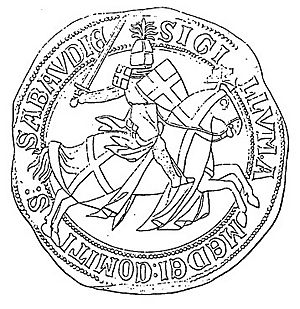Amadeus V, Count of Savoy facts for kids
Quick facts for kids Amadeus V, Count of Savoy |
|
|---|---|

Seal of Amadeus V
|
|
| Count of Savoy | |
| Reign | 1285–1323 |
| Predecessor | Philip I |
| Successor | Edward |
| Born | 1252/1253 Le Bourget |
| Died | 16 October 1323 Avignon |
| Spouse | Sybille of Bâgé Marie of Brabant |
| Issue | Bonne Edward Eleanor Margaret Agnes Aymon Maria Catherina Anna Beatrice |
| House | Savoy |
| Father | Thomas II of Savoy |
| Mother | Beatrice Fieschi |
Amadeus V (born 1252 or 1253 – died October 16, 1323) was a powerful ruler. He was the Count of Savoy from 1285 until his death in 1323. He helped make the County of Savoy much stronger and bigger.
Contents
Early Life and Becoming Count
Amadeus was the son of Thomas II of Savoy and Beatrice Fieschi. His mother's uncle was Pope Innocent IV, a very important religious leader.
When he was younger, Amadeus worked for his cousin, King Edward I of England. He was a knight in Edward's household. He even fought in the First Welsh War in 1277. Later, in 1282, he led Edward's forces at Chester. They helped save Rhuddlan Castle from a siege.
In 1285, Amadeus's uncle, Count Philip I of Savoy, passed away. Philip had no children. Amadeus's older brother had also died earlier. So, Amadeus became the new Count of Savoy. To keep peace in the family, his younger brother, Louis, received a new area called the Barony of Vaud.
Expanding the County of Savoy
Amadeus was very good at growing his lands. He married Sybille of Bâgé in 1272. She was the Countess of Bugey and Bresse. This marriage helped him add these areas to his territory.
He also became the protector of Geneva in 1285. This happened after talks with the Bishop of Geneva. The Count of Geneva, Amadeus II of Geneva, was fighting with the Bishop. Amadeus V stepped in to help.
In 1287, Amadeus captured the castle of Ile near Geneva. This was after a long siege of fourteen weeks. In 1295, he bought the strong fortress at Chambéry. This castle became a very important place for Savoy.
Amadeus even brought a famous artist, Georges de Aquila, to his court. Georges was a student of Giotto, a very famous Italian painter. Georges decorated the castle at Chambéry with beautiful paintings and carvings.
Amadeus won many military victories. These led to the Treaty of Annemasse. In this treaty, the Count of Geneva and the Dauphin of Viennois agreed to become his vassals. This meant they accepted him as their lord. In 1301, he also settled a disagreement over control of Valais.
Important Alliances and Imperial Connections
Amadeus was smart about making friends with powerful leaders. He noticed that the kings of France were expanding their lands. He wanted a strong ally against them.
So, he teamed up with the German king Henry VII. Henry was married to Margaret of Brabant, who was Amadeus's sister-in-law. Amadeus joined Henry on his trip to Italy from 1310 to 1313. This trip ended with Henry becoming the Holy Roman Emperor in 1312.
As a reward for his help, Amadeus received special titles. He became an Imperial Count and an imperial vicar of Lombardy. He also gained control of the cities of Asti and Ivrea. Henry also made Aosta and Chablais into duchies. These areas still remained part of Savoy.
In 1315, Amadeus helped the Knights Hospitaller. They were defending the island of Rhodes from the Turks. Amadeus V passed away in Avignon on October 16, 1323.
Family Life
Amadeus V was married twice and had many children.
His first wife was Sybille of Bâgé. They had eight children together:
- Bonne of Savoy
- John of Savoy
- Beatrice of Savoy
- Edward of Savoy (who became Count after his father)
- Eleonor of Savoy
- Margaret of Savoy
- Agnes of Savoy
- Aymon of Savoy (who became Count after his brother Edward)
His second wife was Marie of Brabant. They had four children:
- Maria of Savoy
- Catherine of Savoy
- Anna of Savoy (who married the Byzantine Emperor)
- Beatrice of Savoy


